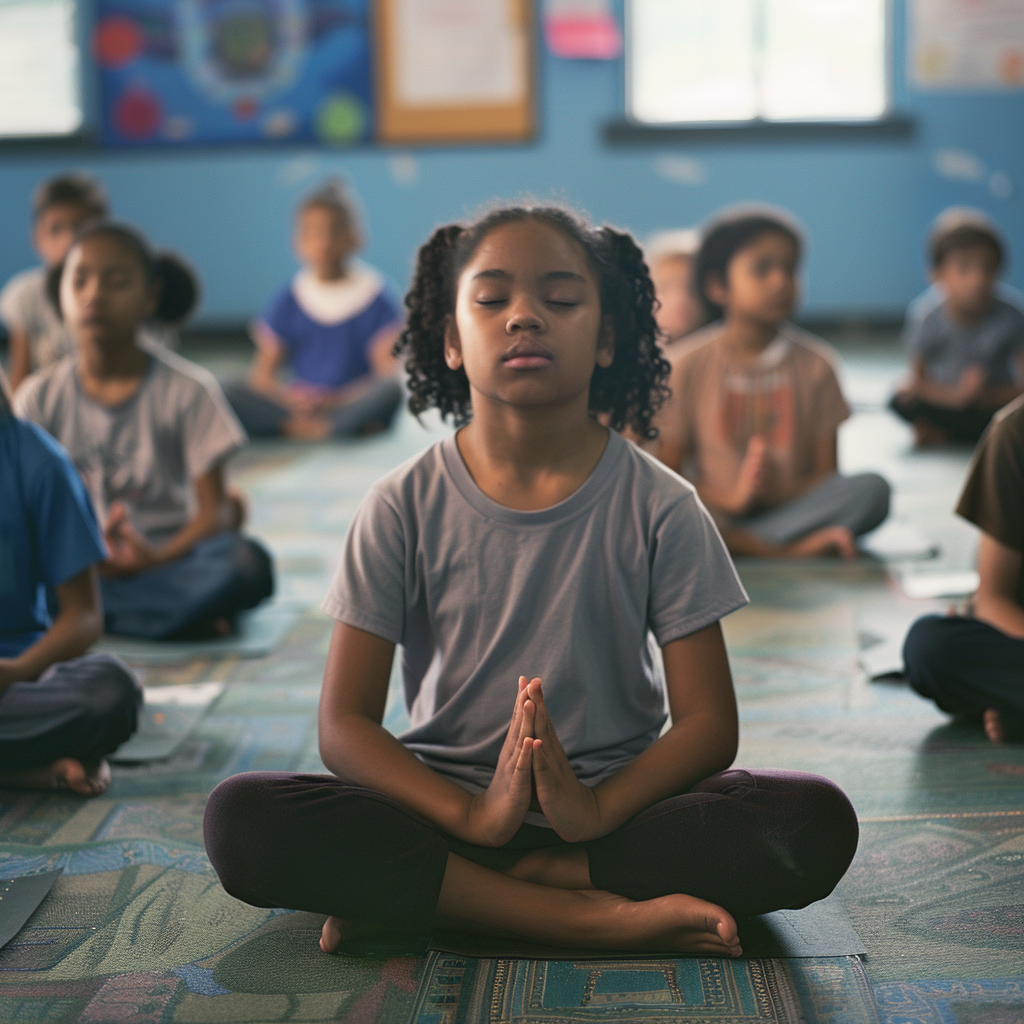Mindfulness and Meditation: Enhancing Student Focus and Well-Being
Integrate mindfulness in class to boost focus, reduce stress, and foster resilient, well-balanced students—practical tips inside.

Imagine a classroom where students not only excel academically but also possess the tools to manage stress, stay focused, and maintain emotional balance. Mindfulness and meditation can make this vision a reality by integrating these powerful practices into daily routines. As stress and anxiety levels rise among students, the need for effective coping strategies has never been greater.
Mindfulness and meditation involve simple yet profound techniques that foster awareness and presence in the moment. These practices have roots in ancient traditions but have been adapted for modern education to support mental health and well-being. By incorporating mindfulness into the classroom, teachers can create a calm and supportive environment conducive to learning and growth.
We will explore the benefits of mindfulness and meditation, practical steps for implementation, and inspiring case studies. Discover how these practices can transform your classroom, enhance student well-being, and promote a positive learning atmosphere. Dive in to learn more about bringing mindfulness and meditation into your educational setting.
Understanding Mindfulness and Meditation
Mindfulness and meditation are practices aimed at fostering awareness and presence in the moment. Mindfulness involves paying attention to one’s thoughts, feelings, and surroundings without judgment. Meditation is a broader practice that includes mindfulness but also involves techniques to focus the mind and achieve a state of calm and clarity.
Historically, these practices have roots in ancient spiritual traditions, particularly Buddhism and Hinduism. Over time, they have been adapted for secular use, particularly in the fields of psychology and education. The modern approach emphasizes their benefits for mental health and well-being.
Enjoy science fiction? Check out my space books HERE on Amazon!
In the educational context, mindfulness and meditation help students manage stress, improve focus, and enhance emotional regulation. These practices create a supportive learning environment where students can better handle academic pressures and interpersonal relationships. By incorporating mindfulness and meditation into the classroom, teachers can equip students with valuable tools for lifelong well-being and resilience.
Benefits of Mindfulness and Meditation in the Classroom
Mindfulness and meditation offer numerous benefits for students, enhancing their emotional, cognitive, and social well-being. Here are some key advantages:
- Emotional Regulation: Helps students manage their emotions more effectively, reducing instances of anxiety, anger, and frustration.
- Improved Focus and Concentration: Enhances students' ability to concentrate on tasks, improving academic performance and productivity.
- Stress Reduction: Lowers stress levels, creating a calmer classroom environment conducive to learning.
- Positive Behavior and Relationships: Promotes kindness, empathy, and positive social interactions, leading to a more supportive and inclusive classroom culture.
- Increased Self-Awareness: Encourages students to reflect on their thoughts and behaviors, fostering greater self-understanding and personal growth.
- Enhanced Resilience: Builds students' ability to cope with challenges and setbacks, contributing to overall mental health and well-being.
- Better Sleep: Practices like guided relaxation can improve sleep quality, which in turn supports better overall health and academic performance.
- Creative Thinking: Encourages open-mindedness and creativity, allowing students to approach problems and projects with fresh perspectives.
These benefits highlight the importance of integrating mindfulness and meditation into the classroom. They not only support academic achievement but also contribute to the holistic development of students, preparing them for future success.
Types of Mindfulness and Meditation Practices
Implementing various mindfulness and meditation practices can help address different needs and preferences in the classroom. Here are some effective types:
- Breathing Exercises: Simple techniques where students focus on their breath to calm their minds. Examples include deep breathing, counted breaths, and alternate nostril breathing.
- Body Scans: Guided exercises where students pay attention to different parts of their body, promoting relaxation and body awareness. This practice helps students identify areas of tension and release stress.
- Mindful Movement: Incorporating gentle movements like yoga or tai chi into the classroom routine. These activities combine physical exercise with mindfulness, enhancing both physical and mental well-being.
- Visualization: Using guided imagery to help students relax and focus. Students are guided to imagine calming scenes or positive outcomes, which can reduce anxiety and improve concentration.
- Mindfulness Journaling: Reflective writing exercises where students document their thoughts, feelings, and experiences. This practice encourages self-awareness and emotional processing.
- Guided Meditation: Listening to a teacher or audio recording that leads students through a meditation session. This can include themes like gratitude, compassion, or stress relief.
- Mindful Listening: Activities where students focus on the sounds around them, enhancing their auditory awareness and attention to the present moment.
These mindfulness and meditation practices can be tailored to fit different classroom settings and student needs, providing a variety of tools to support mental and emotional health.
Implementing Mindfulness and Meditation in the Classroom
Implementing mindfulness and meditation in the classroom requires thoughtful planning and preparation. Start by setting clear goals for the program, such as reducing stress, improving focus, or fostering emotional regulation. Select mindfulness practices that are age-appropriate and resonate with your students, ensuring they are simple to integrate into the daily routine.
Teacher training is essential for the successful implementation of these practices. Provide professional development opportunities focused on mindfulness and meditation techniques. Equip teachers with the skills and confidence to lead sessions effectively. Encourage them to practice mindfulness themselves, as their personal experience can enhance their ability to guide students.
Structuring sessions consistently helps create a supportive environment. Begin with short, daily mindfulness exercises, gradually increasing the duration as students become more comfortable. Integrate these practices into different parts of the school day, such as starting the morning with a brief meditation or incorporating a mindfulness break after recess or lunch.
Utilizing resources and tools can enhance the effectiveness of mindfulness practices. Use apps, videos, and books that provide guided sessions and additional techniques. Create a calm and inviting space in the classroom where students feel comfortable practicing mindfulness. Ensure the environment is free from distractions and conducive to relaxation.
Overcoming Challenges in Implementing Mindfulness and Meditation
Implementing mindfulness and meditation in the classroom can present challenges, but they can be effectively managed with the right strategies. One common challenge is addressing skepticism from students, parents, or staff. To overcome this, communicate the proven benefits of mindfulness and meditation, sharing research and success stories to build understanding and support.
Creating a consistent routine can be difficult amidst a busy school schedule. To address this, start with short, manageable sessions that can be easily integrated into the existing schedule. Gradually increase the length and frequency as students become more accustomed to the practice.
Check out our engaging printable posters. CLICK HERE to explore!
Adapting mindfulness practices to different age groups is essential for engagement. Younger students might benefit from shorter, more interactive activities, while older students can handle longer sessions. Tailor the practices to be age-appropriate and ensure they are engaging and relevant to the students’ experiences.
By proactively addressing these challenges, teachers can create a sustainable and effective mindfulness program that benefits all students. Providing ongoing support and being flexible in the approach will help in successfully integrating these practices into the classroom.
Practical Tips for Teachers
Implementing mindfulness and meditation in the classroom can be straightforward with these practical tips:
- Start Small: Begin with short mindfulness sessions, such as 5-minute breathing exercises, and gradually increase the duration as students become more comfortable.
- Create a Calm Environment: Designate a quiet, comfortable space in the classroom for mindfulness activities. Use soft lighting and calming decorations to set the tone.
- Encourage Consistency: Integrate mindfulness into the daily routine. Schedule regular sessions at the same time each day to build a habit.
- Involve the Whole School: Engage staff and students in school-wide mindfulness initiatives. Organize workshops and training sessions for teachers and hold assemblies to introduce students to mindfulness concepts.
- Use Guided Resources: Utilize apps, videos, and guided meditation recordings to support your mindfulness sessions. These resources can provide variety and structure to your practice.
- Be Patient and Flexible: Understand that students may take time to adapt to mindfulness practices. Be patient and adjust your approach based on their responses and feedback.
By following these tips, teachers can successfully incorporate mindfulness and meditation into their classrooms, creating a more focused, calm, and supportive learning environment for their students.
Future Trends in Mindfulness and Meditation in Education
The integration of technology is a significant trend in mindfulness and meditation practices in education. Apps and online platforms offer guided meditations, breathing exercises, and mindfulness activities that are easily accessible to both teachers and students. This technological integration makes it easier to incorporate mindfulness into daily routines and provides a variety of practices to keep students engaged.
Holistic education models are also gaining traction, combining mindfulness with other wellness practices such as physical exercise, nutrition, and emotional literacy. These comprehensive approaches ensure that students receive a well-rounded education that supports their overall well-being. Schools are beginning to adopt these models to create healthier and more balanced learning environments.
Research and evidence-based practices continue to drive the evolution of mindfulness in education. Ongoing studies are exploring the long-term effects of mindfulness on student performance, behavior, and mental health. As more data becomes available, schools can refine their approaches and implement the most effective strategies to support their students.
These future trends highlight the growing importance of mindfulness and meditation in education. By staying informed and embracing these innovations, educators can enhance their students' learning experiences and promote lasting well-being.
Conclusion
Mindfulness and meditation offer powerful tools to enhance the educational experience by promoting emotional regulation, improving focus, and reducing stress among students. Implementing these practices in the classroom creates a supportive and calming environment that benefits both academic performance and overall well-being. While challenges exist, effective strategies and ongoing support can help integrate mindfulness successfully.
Embracing future trends, such as technological integration and holistic education models, further enriches these practices. By adopting mindfulness and meditation, educators can provide students with essential skills for managing their emotions and improving their mental health, fostering a positive and productive learning atmosphere. Explore these practices to transform your classroom and support your students' growth.
Check out some of my latest science fiction books HERE on Amazon!
Transform your classroom into an inspiring and vibrant learning space with our beautifully designed printable posters! Perfect for engaging your students and enhancing your teaching environment, our poster bundles cover everything from historical philosophers to animals. CLICK HERE to explore our exclusive collections on Teachers Pay Teachers and give your students the motivational boost they need!
